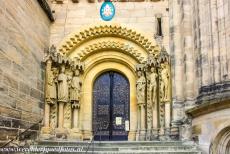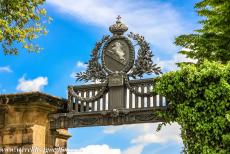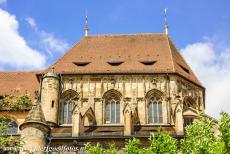The town of Bamberg is a remarkable example of a central European town with a basically early medieval plan. Bamberg stretches over seven hills and each hill is topped by a church. The town of Bamberg is often referred to as the Franconian Rome, because just like Rome, Bamberg was built on seven Hills. The architecture of Bamberg had a strong influence on northern Germany, but also in surrounding countries, such as Poland and Hungary. In the 18th century, Bamberg became a major centre of the Enlightenment in southern Germany. One of the monuments in the town of Bamberg is the 14th century Old Town Hall of Bamberg, built in the middle of the river Regnitz. Several other monuments are the Old Court and New Residence of Bamberg and Bamberg Cathedral. The cathedral houses a unique work of art, the 13th century stone statue of the Bamberger Reiter, the Bamberg Horseman. Little Venice is small a colony of medieval half-timbered fisherman's houses along one side of the River Regnitz. The Baroque New Town Hall of Bamburg was built by Balthasar Neumann between 1732 and 1737, the building is situated on the Maximiliansplatz, the largest town square of Bamberg. The town of Bamberg is situated about 64 km from the World Heritage in Bayreuth and about 95 km from the World Heritage in the city of Würzburg. The town of Bamberg gained status as a UNESCO World Heritage in 1993.
www.werelderfgoedfotos.nl © Copyright World Heritage Photos

The Old Town Hall of Bamberg was built in 1387, after a devastating fire, the Old Town Hall was rebuilt between 1461 and 1467. The Old Town Hall was converted into the Baroque and Rococo styles between 1744 and 1756. From the 10th century onwards, Bamberg was an important link with people of Poland, Pomerania and several other Slavic countries. The town of Bamberg was declared a UNESCO World Heritage in 1993.

The Old Town Hall of Bamberg was built in 1387, after a devastating fire, the Old Town Hall was rebuilt between 1461 and 1467. The Old Town Hall was converted into the Baroque and Rococo styles between 1744 and 1756. From the 10th century onwards, Bamberg was an important link with people of Poland, Pomerania and several other Slavic countries. The town of Bamberg was declared a UNESCO World Heritage in 1993.

The half-timbered Corporal House of the Old Town Hall (on the right hand side) of the town of Bamberg. The Old Town Hall was built in the middle of the river Regnitz and is accessible by two bridges. According to a legend, the bishop of Bamberg did not allow the inhabitants to build the town hall on the existing land, so they created a town hall on a man-made island in the Regnitz River. The Old Town Hall of Bamberg was built in the 14th century.

Town of Bamberg: Numerous marvelous frescoes embellish the exterior walls of the Old Town Hall. The Old Town Hall is situated in the middle of the Regnitz River, this is unique in Germany. The colourful frescoes depict the story of the construction of the town hall in the middle of the Regnitz. The Old Town hall (Altes Rathaus) was converted into the Rococo and Baroque styles in the period 1744-1756, it has a fine Rococo Hall. The Old Town hall was first mentioned in 1387.

Town of Bamberg: Michaelsberg Abbey was founded in 1015 and was built on the Michaelsberg. The Michaelsberg is one of Bamberg's seven hills. Michaelsberg Abbey was rebuilt in neo-Gothic style after a ruinous fire in 1610. The terrace behind Michaelsberg Abbey provides breathtaking views over the town of Bamberg. The former Baroque garden of the abbey is accessible via the Benedictine Path (Benediktiner Weg).

Town of Bamberg: The organ of Michaelsberg Abbey. The vault of the abbey church is decorated with the paintings of 578 flowers and medicinal herbs. The flower beds in the courtyard garden of Michaelsberg Abbey show some of the 578 plants depicting on the vault of the abbey church. The flower beds of the abbey show also plants mentioned in the Bible with the respective Bible verses and the symbolic meaning and healing powers.

Town of Bamberg: The Elisabeth's Church is situated in the centre of the Elisabeth's Square. In the 13th century, the medieval church was built as a chapel of the Elisabeth Hospital. Bamberg is home to the oldest Via Dolorosa in Germany, known as the Bamberger Kreuzweg. The Way of the Cross, the Via Dolorosa, is still completely intact, it is leading from the Elisabeth's Church to the Church of St. Getreu. The Bamberger Kreuzweg is dating back to 1503.

Town of Bamberg: Little Venice (in German: Klein Venedig) viewed from the Leinritt, the towpath on the opposite bank of the river Regnitz. Little Venice was a settlement of fishermen's houses, the picturesque houses of Little Venice are medieval half-timbered buildings, each house had its own jetty. Little Venice is situated along one side of the river Regnitz. The town of Bamberg was inscribed on the World Heritage List in 1993.

Town of Bamberg: The Schöne Pforte, the Beautiful Gateway, is leading into the inner courtyard of the Old Court, the gateway is a sculpted masterpiece. The Old Court was built as a palace for the Prince-Bishops of Bamberg in 1576. The palace is considered to be one of the first German Renaissance buildings. Now, it accommodate the Museum of History and St. Catherine's Chapel. The Old Court (Alte Hofhaltung) was once connected to the Imperial Bamberg Cathedral.

Town of Bamberg: St. Catherine's Chapel is situated in the inner courtyard of the Old Court, the inner courtyard is surrounded by half-timbered buildings. The Old Court (Alte Hofhaltung) is the former imperial court of the Prince-Bishops of Bamberg, they also lived in Geyerswörth Castle. The castle was built between 1585 and 1587. The tower of Geyerswörth Castle offers one of the most splendid views of the historic town of Bamberg.

Town of Bamberg: The Romanesque-Gothic Prince's Portal is the main entrance of the Imperial Bamberg Cathedral. The portal was completed in 1237. As in the Middle Ages, the portal is only used for special occasions. The jambs of the Prince's Portal are embellished with the statues of prophets and apostles, the tympanum over the portal depicts the Last Judgement. The portal is facing the huge Cathedral Square. In winter, the portal is protected from frost by a wood casing. Bamberg Cathedral houses the remains of Pope Clement II who died in 1047.

Town of Bamberg: The Adam's Portal of Bamberg Cathedral, also known as Bamberger Dom St. Peter und St. Georg. The current cathedral was completed in 1237, it shows both Romanesque and Gothic elements. One of the most important sights inside the cathedral is the statue of the Bamberger Reiter. Some other important sights inside Bamberg Cathedral are the tomb of the imperial couple Heinrich II and Kunigunde, carved in 1513, the Marienaltar (1523), the statue of Bishop Friedrich von Hohenlohe (1352) and 13th century papal tomb of Clemens II.

Town of Bamberg: The renowned statue of the Bamberger Reiter, the Bamberg Horseman. The Bamberger Reiter was created around 1235 by an unknown artist. The noble figure of the horse and the regal posture of the rider illustrate the dignity of a noble man, but it is uncertain who he is. The Imperial Bamberg Cathedral is adorned with masterly stone sculptures, the statue of the Bamberger Reiter is the most important sculpture in the cathedral.

Town of Bamberg: The entrance gate into the New Residence. The residence was built in 1602, the Baroque wings were built in 1697-1703. The Prince Bishops of Bamberg lived and governed in the New Residence until 1802. The New Residence (Neue Residenz) accommodate valuable collections of paintings. The Rose Garden, designed by Balthasar Neumann, has preserved its Baroque appearance, it offers marvelous views over the town of Bamberg and St. Michaelberg.

Town of Bamberg: The Baroque interior of the St. Stephan or St. Stephen 's Church, the church was built on the most eastern of the seven hills of Bamberg. The St. Stephan is dedicated to the martyr Stephanus. The church was probably a gift from the Holy Roman Empress Kunigunde. The St. Stephan was consecrated by Pope Benedict III in 1020. The present church was built in the 17th century and has been the main Protestant church of the town of Bamberg since 1807.

Town of Bamberg: A roofline detail of the Baroque Villa Concordia. The water castle was built in the period 1716-1722. Villa Concordia was built on the banks of the river Regnitz. Nowadays, it is home to the International Artists House Villa Concordia. In the 12th century, the architecture of Bamberg had a strong influence on the architecture in northern Germany, but also in a number of surrounding countries, such as Poland and Hungary.

Town of Bamberg: The birth house of Joseph Heller, a wealthy merchant and an art collector, he donated his art collections to the Bamberg State Library. In the 18th century, Bamberg became a centre of the Enlightenment in southern Germany. The medieval and Baroque architecture of Bamberg strongly influenced northern Germany and Hungary. Philosophers and writers such as Hegel and Hofmann lived in Bamberg. Claus von Stauffenberg also lived in Bamberg.

The Obere Pfarre, the Upper Parish, is the only pure Gothic church in the town of Bamberg. The Wedding Portal is decorated with Gothic statues. The Obere Pfarre was built between 1338 and 1350, it stands on the Obere Pfarre Hill, the Upper Parish Hill, one of the seven hills of Bamberg. The official name of the Upper Parish is the Church of Our Lady. Bamberg is often referred to as the Franconian Rome, because just like Rome, Bamberg was built on seven Hills.

Town of Bamberg: The Baroque interior of the Upper Parish, the Obere Pfarre, dates from 1711. The nave of the church is 50 years older than the Late Gothic chancel, whose foundations dates from 1375, flying buttresses support the high chancel. The Upper Parish houses a 16th century painting by the famous Venetian painter Tintoretto: Assumption of the Virgin Mary. The church is called the Upper Parish by the locals, the official name is the Church of Our Lady.

Town of Bamberg: The Maximilian Fountain and the Baroque New Town Hall. The fountain was built on the Maximiliansplatz in 1880. The fountain is decorated with statues, such as statues of King Maximilian I of Bavaria, Emperor Heinrich II and Empress Kunigunde. The Maximiliansplatz is the largest square in Bamberg, named 'Maxplatz' in short, and is dominated by the New Town Hall of Bamberg, built by Balthasar Neumann between 1732 and 1737.

Town of Bamberg: The New Residence and Bamberg Cathedral viewed from the Michaelsberg. The town of Bamberg stretches over seven hills and each hill is topped by a church. The town is home to numerous monuments from the 11th to the 18th centuries. Bamberg consists of three historic centres, Bergstadt, Inselstadt and Gärtnerstadt. All the centres are part of the UNESCO World Heritage. The town of Bamberg gained the status as a UNESCO World Heritage in 1993.
